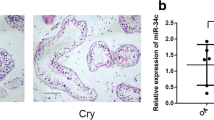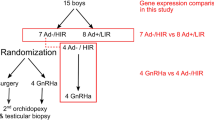Summary
In our previous study, we identified a novel testis-specific expressed gene 2 (TSEG-2) from mouse testis. To further investigate its functions, 35 male Balb/c mice (8 weeks old) were divided into cryptorchidism group (n=20), sham group (n=10), and control group (n=5). In cryptorchidism group, the right testes were anchored to the inner lateral abdominal wall. In situ hybridization (ISH) was applied to measure the localization of TSEG-2 in mouse testis. Real-time quantitative PCR was performed to detect the expression of TSEG-2 gene. Meanwhile, under the mediation of polyethylenimine (PEI), the recombinant vector pEGFP-TSEG-2 (n=5) or empty vector (mock, n=5) was transfected into the testis of male mice. The transfection efficiencies were measured under a fluorescence microscope. The apoptosis of spermatogenic cells was detected by terminal deoxynuleotidyl-mediated nick end labeling (TUNEL). The results showed that TSEG-2 was expressed in convoluted seminiferous tubules, more precisely, in spermatogonia and spermatocytes. As compared with sham and control groups, the TSEG-2 transcription was significantly enhanced (P<0.05) and was correlated with apoptosis of spermatogenic cells in cryptorchid testes (P<0.05). PEI was efficient in mediating transfection of TSEG-2 into seminiferous tubules of testis. One week post-transfection, intratesticular injection of TSEG-2 resulted in increased apoptosis of spermatogenic cells in vivo (P<0.05). These results indicate that TSEG-2 may participate in the apoptosis of spermatogenic cells and the pathogenesis of cryptorchidism.
Similar content being viewed by others
References
Sha JH, Zhou ZM, Li JM, et al. Expression of a novel bHLH-Zip gene in human testis. Asian J Androl, 2003,5(2):83–87
Kashiwabara S, Noguchi J, Zhuang T, et al. Regulation of spermatogenesis by testis-specific, cytoplasmic poly(A) polymerase TPAP. Science, 2002,298(5600):1999–2002
Yu Z, Guo R, Ge Y, et al. Gene expression profiles in different stages of mouse spermatogenic cells during spermatogenesis. Biol Reprod, 2003,69(1):37–47
Wang ZY, Tong QS, Zeng FQ, et al. Cloning and expression of a novel mouse testis gene TSEG-2. Zhonghua Nan Ke Xue (Chinese), 2009,15(2):99–105
Braissant O, Wahli W. A simplified in situ hybridization protocol using non-radioactively labeled probes to detect abundant and rare mrnas on tissue sections. Biochemica, 1998,1:10–16
Farooqui SM, Al-Bagdadi F, Houslay MD, et al. Surgically induced cryptorchidism-related degenerative changes in spermatogonia are associated with loss of cyclic adenosine monophosphate-dependent phosphodiesterases type 4 in abdominal testes of rats. Biol Reprod, 2001,64(6):1583–1589
Mendis-Handagama SM, Kerr JB, De Kretser DM. Experimental cryptorchidism in the adult mouse. III. Qualitative and quantitative electron microscopic morphology of Leydig cells. J Androl, 1991,12(5):335–343
Li L, Min L, Min X, et al. Gene functional research using polyethylenimine-mediated in vivo gene transfection into mouse spermatogenic cells. Asian J Androl, 2006,8(1):53–59
Ogawa T, Arechaga JM, Avarbock MR, et al. Transplantation of testis germinal cells into mouse seminiferous tubules. Int J Dev Biol, 1997,41(1):111–122
Virtanen HE, Bjerknes R, Cortes D, et al. Cryptorchidism: classification, prevalence and long-term consequences. Acta Paediatr, 2007,96(5):611–616
Rockett JC, Mapp FL, Garges JB, et al. Effects of hyperthermia on spermatogenesis, apoptosis, gene expression, and fertility in adult male mice. Biol Reprod, 2001, 65(1):229–239
Hunter ES 3rd, Dix DJ. Heat shock proteins Hsp70-1 and Hsp70-3 are necessary and sufficient to prevent arsenite-induced dysmorphology in mouse embryos. Mol Reprod Dev, 2001,59(3):285–293
Peluffo H, Aris A, Acarin L, et al. Gene delivery to the central nervous system based on a novel integrin-targeting multifunctional protein. Hum Gene Ther, 2003,14(13):1215–1223
Pack DW, Hoffman AS, Pun S, et al. Design and development of polymers for gene delivery. Nat Rev Drug Discov, 2005,4(7):581–593
Boussif O, Lezoualch F, Zanta MA, et al. A versatile vector for gene and oligonucleotide transfer into cells in culture and in vivo: Polyethylenimine. PNAS, 1995, 92(16):7297–7301
Godbey WT, Barry MA, Saggau P, et al. Poly(-ethyleni-mine)-mediated transfection: a new paradigm for gene delivery. J Biomed Mater Res, 2000,51(3):321–328
Bmnner S, Sauser T, Carotta S, et a1. Cell cycle dependence of gene transfer by lipoplex, polyplex and recombinant adenovirus. Gene Ther, 2000,7(5):401–407
Author information
Authors and Affiliations
Corresponding author
Additional information
This project was supported by grants from the National Natural Sciences Foundation of China (No. 30200284, No. 30600278, No. 30772359), Program for New Century Excellent Talents in University (NCET-06-0641), and Scientific Research Foundation for the Returned Overseas Chinese Scholars (2008-889).
Rights and permissions
About this article
Cite this article
Hu, T., Wang, Z., Zeng, F. et al. Expression pattern of testis-specific expressed gene 2 in cryptorchidism model and its role in apoptosis of spermatogenic cells. J. Huazhong Univ. Sci. Technol. [Med. Sci.] 30, 193–197 (2010). https://doi.org/10.1007/s11596-010-0212-3
Received:
Published:
Issue Date:
DOI: https://doi.org/10.1007/s11596-010-0212-3




